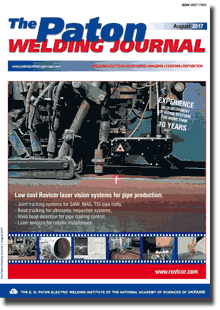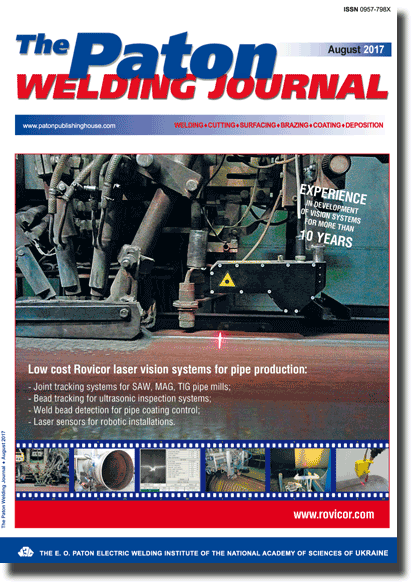| 2017 №08 (01) |
DOI of Article 10.15407/tpwj2017.08.02 |
2017 №08 (03) |

The Paton Welding Journal, 2017, #8, 12-17 pages
Brazing filler metal without boron and silicon for brazing of heat-resistant nickel alloy
S.V. Maksymova, V.V. Voronov and P.V. Kovalchuk
E.O. Paton Electric Welding Institute, NASU 11 Kazimir Malevich Str., 03680, Kiev, Ukraine. E-mail: office@paton.kiev.ua
Abstract
The use of nickel brazing filler metals, containing boron and silicon as depressants, provides a good wetting of material brazed, allows a significant reduction in brazing temperature, but leads to formation of brittle phases and low-melting eutectics in the brazed welds. This work shows the possibility of forming brazed joints of cast heat-resistant nickel alloy ZhS6U applying brazing in vacuum with use of multicomponent nickel brazing filler metals which do not contain boron and silicon as depressants. Applying the method of high-temperature differential thermal analysis in atmosphere of high-purity helium, the temperatures of liquidus and solidus of brazing filler metals were determined. The results of metallographic and micro-X-ray spectral examinations on studying the features of structure formation of brazed welds are presented. The long-term strength of the brazed joints was evaluated. It is shown that nickel brazing filler metals, containing a large concentration of zirconium, are characterized by a lower melting point, however, in the brazed welds the precipitations of the phase Ni(Me)xZr are formed. It was determined that decrease in the concentration of zirconium in the nickel brazing filler metal allows avoiding the formation of intermetallic phase enriched in zirconium and obtaining a solid nickel-based solution as the predominant phase in the weld. The results of tests of flat brazed (butt) specimens on long-term strength, carried out at the elevated temperature of 975 °C and the stress of 140 MPa, showed that the joints preserve integrity and do not fracture after 41–60 h of testing. It is shown that zirconium can act as an alternative depressant (instead of mutual adding of boron and zirconium). 13 Ref., 3 Tables, 8 Figures.
Keywords: vacuum brazing, heat-resistant nickel cast alloy, liquidus temperature, solidus, microstructure, multicomponent brazing filler metal, brazed joint, long-term strength
Received: 20.04.17
Published: 01.08.17
References
- Paton, B.E., Stroganov, G.B., Kishkin, S.T. et al (1967) Heat-resistance of cast nickel alloys and their protection from oxidation. Kiev: Naukova Dumka.
- (2006) S.T. Kishkin effect. Ed. by E.N. Kablov. In: Cast heat-resistant alloys: Transact. Moscow: Nauka.
- Khorunov, V.F., Maksymova, S.V., Ivanchenko, V.G (2004) Development of filler metals for brazing heat-resistant nickel- and titanium-base alloys. The Paton Welding J., 9, 26–31.
- Ermolaev, G.V., Kvasnitsky, V.V., Kvasnitsky V.F. et al. (2015) Brazing of materials. Mykolaiv: NUS.
- Maksymova, S.V. (2007) Amorphous filler metals for brazing of stainless steels and titanium and structure of brazed joints. Adgeziya Rasplavov i Pajka Materialov, 40, 70–81.
- Khorunov, V.F., Maksymova, S.V. (2013) Advanced in brazing. Science, technology and applications. UK: Cambridge: Woodhead Publ. Ltd.
- Khorunov, V., Maksymova, S., Samokhin, S. et al. (2001) Brazing filler metal containing Zr and Hf as depressants. In: of 3rd Int. Conf. on High Temperature Capillarity HTC-2000 (Kurashiki, Japan 2000). Osaka.
- Rabinkin, A. (2013) Advances in brazing science, technology and applications. UK: Cambridge: Woodhead Publ. Ltd.
- Malashenko, I.S., Kurenkova, V.V., Belyavin, A.F. et al. (2006) Short-term strength and microstructure of brazed joints of alloy VJL12U produced using boron-containing brazing filler metal with addition of silicon. Advances in Electrometallurgy, 4, 23–38.
- Arafina, M.A., Medraja, M., Turnerb, D. (2007) Transient liquid phase bonding of Inconel 718 and Inconel 625 with BNi-2: Modeling and experimental investigations. Sci. & Engin. A, 447(1/2), 125–133. https://doi.org/10.1016/j.msea.2006.10.045
- Chaturvedi, M.C., Ojo, O.A., Richards, N.L. (2004) Diffusion brazing of cast Inconel 738 superalloy. Advances in Technol.: Materials & Materials Proc., 2(6), 206–213.
- Massalski, T.B. (1990) Binary alloy phase diagrams. American Society for Metals. Metals Park: ASM International: CD).
- Kurochko, R.S. (1982) Welding and brazing of heat-resistant materials of GTE hot section. Promyshlennost, 8. http://viam.ru/public/files/1982/1982-198570.pdf
Suggested Citation
S.V. Maksymova, V.V. Voronov and P.V. Kovalchuk (2017) Brazing filler metal without boron and silicon for brazing of heat-resistant nickel alloy. The Paton Welding J., 08, 12-17.The cost of subscription/purchase order journals or individual articles
| Journal/Currency | Annual Set | 1 issue printed |
1 issue |
one article |
| TPWJ/USD | 384 $ | 32 $ | 26 $ | 13 $ |
| TPWJ/EUR | 348 € | 29 € | 24 € | 12 € |
| TPWJ/UAH | 7200 UAH | 600 UAH | 600 UAH | 280 UAH |
| AS/UAH | 1800 UAH | 300 UAH | 300 UAH | 150 UAH |
| AS/USD | 192 $ | 32 $ | 26 $ | 13 $ |
| AS/EUR | 180 € | 30 € | 25 € | 12 € |
| SEM/UAH | 1200 UAH | 300 UAH | 300 UAH | 150 UAH |
| SEM/USD | 128 $ | 32 $ | 26 $ | 13 $ |
| SEM/EUR | 120 € | 30 € | 25 € | 12 € |
| TDNK/UAH | 1200 UAH | 300 UAH | 300 UAH | 150 UAH |
| TDNK/USD | 128 $ | 32 $ | 26 $ | 13 $ |
| TDNK/EUR | 120 € | 30 € | 25 € | 15 € |
AS = «Automatic Welding» - 6 issues per year;
TPWJ = «PATON WELDING JOURNAL» - 12 issues per year;
SEM = «Electrometallurgy Today» - 4 issues per year;
TDNK = «Technical Diagnostics and Non-Destructive Testing» - 4 issues per year.


